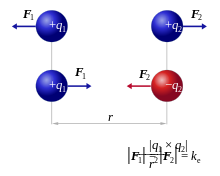Metal oxides

Metal oxides are compounds between a metal and oxygen . Due to the Elektronegativitätsunterschiedes of little electronegative metal and the highly electronegative oxygen, the compounds are generally ionic or at least strongly polar.
Knowledge of metal oxide surfaces plays a role in corrosion protection , catalysis , sensors, fuel cells , ceramics and others.
Structure: bulk properties
Knowledge of the structure of metal oxides helps to understand their further properties. The analysis of the bulk structure has become possible through the invention of X-ray structure analysis . In the following, an ideal bulk structure at absolute zero is first considered, which can then be supplemented with defects, vibrations and other aspects.
Ideal crystal structure
The properties of the metal oxides can first be understood based on their ionicity. The driving force for this is the tendency of the oxygen 2s 2 2p 6 - configuration to obtain (an O 2 being anion). The proportion of ionic bonds varies at a high level in metal oxides; bonds of the late transition metals have a relatively strong covalent proportion . Due to the high ionic content of the bond of metal oxides, Coulomb forces act , which give stoichiometry a special role: Even in small areas, charge neutrality must prevail. This charge neutrality plays an important role both in volume and on the surface. Due to the ionic nature of the crystal, charge is spatially strongly localized. The atoms of the crystal (both cations and anions) prefer a certain ionic charge as the most energetic state. Therefore, adding or removing electrons requires energy. This is in contrast to the band model (which can also be used for metal oxides) , in which the occupation with electrons is calculated for a certain crystal structure and only one total charge would be taken into account. These considerations have an impact on the electrical conductivity: Since the anions are already completely occupied with electrons, the cations are responsible for any conductivity. If a current is passed, this takes place by shifting an electron from the d orbital of a cation into the d orbital of another cation: d n d n → d n-1 d n + 1 . This process is energy-intensive, the necessary energy can be determined according to the Coulomb repulsion or the Hubbard model . If this energy becomes too great, the material is a semi-conductor or non-conductor.
The two determining quantities of metal oxides are their stoichiometry (the atomic ratio) and their coordination (the number of ions surrounding one another and their arrangement). The common structures can be classified in different arrangements . These are:
- tetrahedral
- square planar
- octahedral
- Distorted octahedral
- cubic
These coordinations can be found in the basic structural types.
Sixfold (octahedral) coordination is most common, it is found in the sodium chloride structure. The sodium chloride structure can be found among other things in metal oxides MO (metal: oxide ratio = 1: 1), in the crystal structure of corundum (M 2 O 3 ) and the crystal structure of rutile (MO 2 ). The eightfold coordination in the fluorite structure of uranium (IV) oxide can be found as a higher coordination, for example , the fourfold coordination of the wurtzite crystal structure in zinc oxide, for example . A few other irregular structures are related to the Jahn-Teller effect .
Lattice failure

While a theoretical crystal is perfectly regular and faultless, this is not the case with real structures: For thermodynamic reasons, a crystal above 0 K always has defects or lattice defects . Lattice defects are more common on surfaces than in bulk crystals; they can have a major impact on the catalytic and chemical properties of the material. While most major non-transition metal oxides have only one oxidation state ( tin oxide is a major exception ), the opposite is true for transition metals. This facilitates the formation of oxygen vacancies ( point defects ). When an oxygen atom is removed from the crystal, electrons left behind by it can be absorbed by the metal cations and the defect can be stabilized, for example 2 MoO 3 → O 2 + MoO 2 (reduction of molybdenum from Mo 6+ to Mo 4+ ). This plays a role, for example, in the oxygen storage capacity of the cerium oxide in the three-way catalytic converter . After removing the oxygen, the material is partially reduced and now has a mixed valence. If this reduction of the surface is continued, the oxygen vacancies form clusters until the surface is almost completely reduced. In addition to the point defect mentioned, there are numerous other lattice defects.
Individual evidence
- ↑ a b c d e Victor E. Henrich, PA Cox: The Surface Science of Metal Oxides . Cambridge University Press, 1996 ( pages 14-22 in Google Book Search).
- ↑ a b c D. P. Woodruff: The chemical physics of solid surfaces: Surface alloys and alloy surfaces, Volume 10 . Elsevier, 2002 ( pages 3–6 in Google Book Search).

